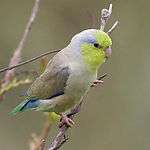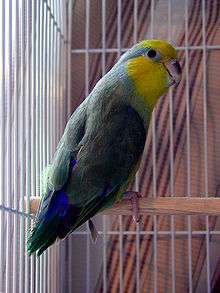Forpus
| Forpus | |
|---|---|
 | |
| Blue-winged parrotlet (Forpus xanthopterygius) | |
| Scientific classification | |
| Kingdom: | Animalia |
| Phylum: | Chordata |
| Class: | Aves |
| Order: | Psittaciformes |
| Superfamily: | Psittacoidea |
| Family: | Psittacidae |
| Subfamily: | Arinae |
| Genus: | Forpus F. Boie, 1858 |
| Species | |
|
see text | |
Forpus is a genus of parrot in the family Psittacidae.
Species
- Mexican parrotlet (Forpus cyanopygius)
- Green-rumped parrotlet (Forpus passerinus)
- Blue-winged parrotlet (Forpus xanthopterygius)
- Spectacled parrotlet (Forpus conspicillatus)
- Dusky-billed parrotlet (Forpus modestus)
- Pacific parrotlet (Forpus coelestis)
- Yellow-faced parrotlet (Forpus xanthops)
Description
Forpus parrots, also known as parrotlets, are sexually dimorphic. Males have somewhat dull colors but have a bright blue streak on their wings and eye. Females have bright colors and do not have the blue on the wing. They may or may not have it on the eye. Some parrotlet species are exceptions; but it is usually easy to tell them apart.
Aviculture
Parrots in the Forpus genus are commonly kept as pets with at least one partner. They are very social and will often show signs of depression if kept alone. One has to consider that Forpus parrots, especially the male birds, can be very loud and need enough space to fly and roam in. Like any other parrot, (due to their strong beaks) they usually spend their time socializing with their partner, nagging preferably on woods (bark, e.g. Corkbark) and porous rocks. Due to their curiosity exposure to toxic material like plastic (e.g. window seals), toxic plants and chemically treated objects should be strictly avoided, especially galvanized wires (falsely used as cheap material for aviaries, have led to many cases of intoxication). They are not easy to breed as they are extremely aggressive and will sometimes kill or severely maim their partners. They are known for biting attacks, usually aimed to their partners claws. Green-rumpeds aren't much of biters but they don't usually talk as well. Mexican, spectacled, and yellow-faced parrotlets are rarer in the U.S. but are found captive in other places as well. Dusky-billed, also more commonly known as Sclater's parrotlets are extremely rare and are only found captive in Europe.
Species photographs
 Green-rumped parrotlet (Forpus passerinus)
Green-rumped parrotlet (Forpus passerinus) Blue-winged parrotlet
Blue-winged parrotlet
(Forpus xanthopterygius) Spectacled parrotlet
Spectacled parrotlet
(Forpus conspicillatus) Pacific parrotlet
Pacific parrotlet
(Forpus coelestis) Yellow-faced parrotlet
Yellow-faced parrotlet
(Forpus xanthops)